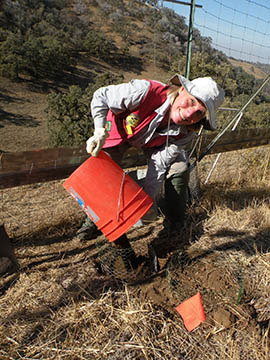Cronkite News has moved to a new home at cronkitenews.azpbs.org. Use this site to search archives from 2011 to May 2015. You can search the new site for current stories.
ASU researchers studying how to preserve tree species amid climate change
TEMPE – Two researchers at Arizona State University are aiming to help officials manage trees based on how different types are affected by climate change.
Janet Franklin, a geography professor, and Pep Serra-Diaz, a postdoctoral researcher, are using computer models to study how quickly a tree species and its habitat will be exposed to climate change. That information is used to locate areas with specific elevations and latitudes where trees could survive and repopulate.
“This is information that would hopefully be useful to foresters, natural resource (agencies and) policymakers because they could say, ‘OK, here’s a region where the tree or this forest may not be at as much risk of climate change … where we might want to focus our management attention,’” Franklin said.
Serra-Diaz was the lead author of a peer-reviewed article that appeared in the journal Diversity and Distributions. Franklin and researchers from other universities were co-authors.
The role of both ASU researchers was computer modeling; Serra-Diaz focused on mathematical data, while Franklin specialized in spatial and geographical data.
The study is part of the collaborative “Do microenvironments govern macroecology?” project, which was awarded a grant from the National Science Foundation. The project also involves the U.S. Geological Survey, the Desert Research Institute and Frank Davis, a professor at UC Santa Barbara, among other professors, Franklin said.
The study’s main goal is checking exposure patterns at a specific forest location, in this case along the west coast of California, and expanding them to a global level, Serra-Diaz said.
But each tree species differs in how it is exposed and how quickly that exposure takes place, even if different species are in similar locations, Serra-Diaz said.
“What we mean by exposure is how the conditions will change with respect to what the species is used to,” he said. “We need to know how the species reacts and (its) capacity to adapt.”
Macro-level data could hide some small areas, such as cooler mountain valleys, where temperatures differ and a tree species might be better able to survive, Serra-Diaz said.
Franklin is also working on a separate study with Davis from UC Santa Barbara that expands upon the idea of finding those refuges among different terrains in California’s mountain ranges.
Pine and oak seedlings were planted in experimental gardens at different elevations to see which location and temperature would provide the most suitable living conditions when the climate changes, Franklin said.
“Our hypothesis is that the seedling stage is the vulnerable stage in the forest,” she said.
The biggest problem facing the migration of tree populations in anticipation of climate change is that trees can’t just move, Franklin said.
“The way a plant migrates is that a seed falls or gets carried to a new place and progressively it only survives in the place that’s becoming climatically suitable,” she added.
Because trees have previously shifted or migrated during ice ages, the study compared the temperature increases of those climate changes with future ones.
“It’s a good analog to study the past to anticipate what might happen in the future, but there’s a catch: The anthropogenic global warming is projected to happen much more quickly,” Franklin said.
While a global temperature change of 10 degrees might have taken tens of thousands of years in the past, that same temperature change now is projected to occur in less than 100 years, she said.
Human and agricultural use of land has also fragmented it to a point of difficult comparison between then and now, Franklin said.
“The problem for ecosystems is this very compressed timescale and the problem for people is the ecosystem services that we expect from those forests,” she said.







